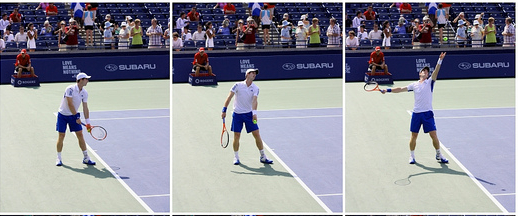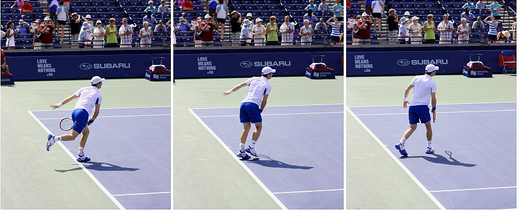Perhaps Andy Murray’s serve has not received much praise from TV Commentators, but I’ve decided to learn more about the technical motion. Like the rest of Andy Murray’s game, his serve is not a overwhelming weapon, but a shot used to set up the point using finesse and high percentage plays.
Andy Murray’s Serve: Background
World number four Andy Murray has been a solid top five player for almost four years now. He first gained notice at Wimbledon in 2005 when he reached the third round. He has steadily improved his results there since.
In his past three appearances, he has lost in the semi-finals. You can expect that next year, all of Great Britain will continue to fervently pin their hopes upon him to become the first British champion since 1977 and their first male champion since 1936. Murray has also reached the final of the Australian Open twice and the US Open once. Unfortunately, he lost each time in straight sets and has been criticized for not putting up a better effort.
Andy Murray’s Serve: Setting Up The Point
Murray is an intelligent and crafty player. He has shown a steep learning curve since his early days on tour and is beginning to fashion out a more aggressive approach to winning points. His usual style is defensive and counterpunching. He lets the point develop and waits patiently for the opponent to make an error or a short ball by varying his shots.
Once he gets the short ball, he puts it away. He also likes to bring opponents who are not comfortable volleying up to the net with drop shots. Once they are there, he will hit precise passing shots or lobs.With his height, reach and build, the Andy Murray serve is a formidable shot. However, he has not maximized its effect by playing a more proactive style of winning points. Still, this shot provides him with the proper foundation upon which to build a more aggressive style.
Andy Murray Serve Technique
The Andy Murray serve begins with him lining up at a 45 degree angle to the baseline. His legs are a little more than body width apart with the left foot about 30 degrees off the line. This stance means that he will be using a big turn of the whole body to assist in providing some of the power to his serve. His arms are extended out in front. His left hand holds the ball and supports the racket at the shoulder of the frame. The right hand grips the racket in a continental grip.


The actual motion of the Andy Murray serve begins as he tosses the ball. He loads up his weight on the back foot and his tossing arm starts to go up but it is almost parallel to the baseline. For him, this assists in the coil of the shoulders. The hips and torso begin to wind up. The racket is taken back in a semi-circular motion up to the trophy position. It is a more compact way of taking the racket up but not as abbreviated as someone like Andy Roddick, who takes the racket straight up.


Andy Murray Serve: Trophy Position
At the trophy pose, he brings his feet close together as he bends his knees. This is called the pinpoint stance. Other players like Roger Federer keep their feet apart. His weight is now more concentrated on his left leg but since the feet are close together, both legs will be used to provide propulsion into the shot.
Also, this motion will result in a greater overall forward motion on the serve. Murray will be pushing off the ground and launching up to the ball later in the sequence. The only drawback of moving the back foot up close to the front foot is that it partially inhibits the fluidity of the coiling action. Therefore, the torso and upper body have a greater responsibility of providing the power of the shot.


Andy Murray Serve: Head Position
His head really looks up to the ball, which he has now tossed up. The toss itself is a little high but well placed and forward. The height of the toss ensures that he will be fully extended at contact. The position of the toss also means that he will be hitting the ball upward and forward. This is ideal for maximum power and control. His tossing arm is now extended up and outward.
Andy Murray Serve: Upward Swing
The forward swing phase of the Andy Murray serve sees his racket taken back into the back scratch position as he starts to push off the ground with both feet. His legs extend and his hips begin to uncoil. As this motion continues, the torso and the shoulders follow, bringing the elbow up.
The right shoulder is now higher than the left shoulder and the non-dominant arm is now lowered. The wrist remains cocked back. The elbow then extends before the forearm starts to pronate and the wrist straightens out.


Andy Murray Serve: Contact Point
The contact point of the Andy Murray serve is at the peak of the toss. His feet have left the ground and his torso continues uncoiling. At contact, his chest is facing the net. The forearm pronates and whips the racket face through the ball. Murray has the versatility to hit different kinds of spin serves including the kick and slice serves. His follow through will be different depending on the type of serve he has hit.
On a flat serve, he hits the ball squarely behind it and finishes forward and a little bit to the left side of the body. On the slice serve, his carves through the ball on its right side with the resulting follow through going more across his body.


The kick serve sees him brush the ball upward and forward from 8 o’clock to 2 o’clock and finish high, forward and on the same side of his hitting arm. He lands inside the baseline on his left foot. He does not finish with his body and right leg parallel to the ground. Instead, he is more at a 30-45 degree angle. Regardless, he has transferred his full weight into the shot.
Murray’s Serve: A Set Up Shot


Also, this method of finishing the stroke will enable him to recover more quickly for the next shot. After landing both feet, he reverts back quickly to the ready position.
The Andy Murray serve is used more as a set-up shot. As previously mentioned, with his ability to hit great serves, he should be looking immediately to attack after the serve. When he is serving well, his first serve is very difficult to return. But his passive mind set makes it much easier for his rivals.
When opponents see that he is not going after the point offensively, they are under less pressure to return well and ironically start to return better. Murray then has to rely more on his return to try to control the points. He actually has developed an excellent return off both sides.
Like Andre Agassi, he has the ability to take the return very early and fire back a shot that puts the opponent immediately in trouble. But as with his serve, he usually prefers to get a rally going and work the point from there. More often, he will just absorb the pace of the serve and send it back deep. The drawback to this approach is that he is at the mercy of a player who is serving the lights out.
The serve and return are the two most important shots in the game. Murray is outstanding in both departments, but he has largely failed to capitalize on these strengths on the biggest occasions. A major part of the problem is psychological.
Andy Murray Serve: Dealing With Pressure
Andy Murray somehow must do a better job of handling the pressure. But this problem also stems from his natural tendency to play defensively. At the last two Australian Opens, where Murray was runner up first to Federer and then this year to Novak Djokovic, he played too passively and meekly while his opponent was really taking it to him. If he had been more assertive, especially in his service games, he would have been far more competitive. Maximizing strengths and bravely going for the big shots pays off with big rewards. The sooner he realizes this, the sooner he will win his first grand slam title.
Learn to Hit a Forehand Like Roger Federer
If you want to jumpstart your forehand and play like the PROS, check out my 70+ page Tennis Ebook that will immediately show you how you can take your forehand to the next level.
The Modern Forehand Domination Ebook is guaranteed to improve your tennis technique, and increase power, topspin and accuracy of your tennis forehand!
Modern Tennis Forehand Ebook
Learn How to Hit a Forehand Like Federer, Nadal and Djokovic

